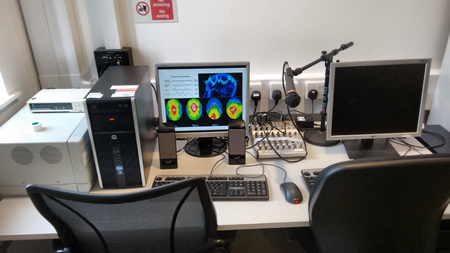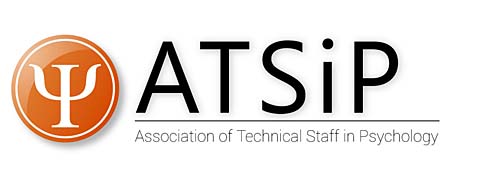|     
|
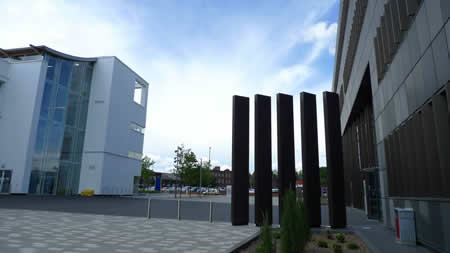
|
ATSiP ANNUAL CONFERENCE
Staffordshire University
24th-26th June 2015
|
ATSIP Staffordshire Report 2015
Location and accommodation:
ATSIP travelled to Staffordshire University for the 30th Annual Conference. The accommodation was in Halls of Residence.
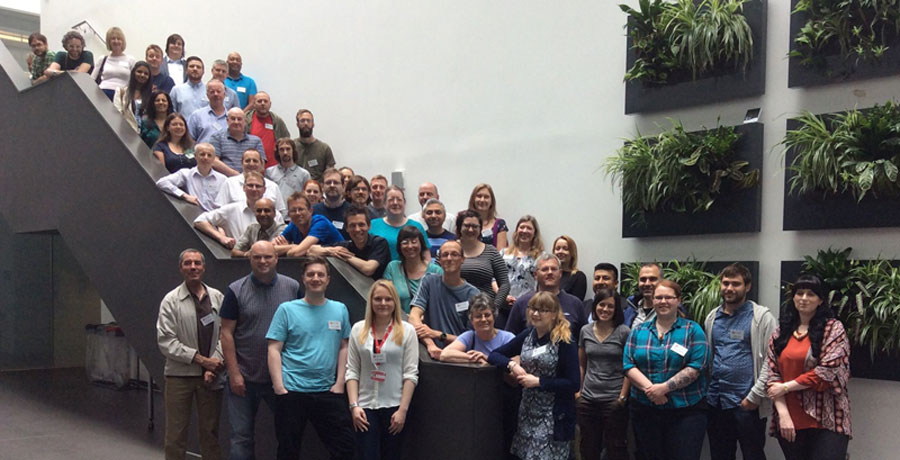
|

The 2015 conference had a record attendance, with more papers presented than any previous ATSiP conference, and for the first time there was also a poster presentaton. |
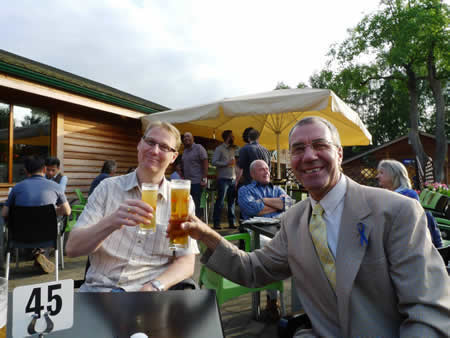


|
| The Conference:
Abstracts to the talks:
Wednesday 24th June
Effectiveness of Audience Participation Software (Turning Point) in Statistical Teaching and Learning
Prof David Clark-Carter, Staffordshire University
How to bring statistics to life within research methods sessions. This is a brief interactive session to demonstrate how influential Turning Point can be in gaining real time statistics and student understanding of statistical concepts.
.
. |
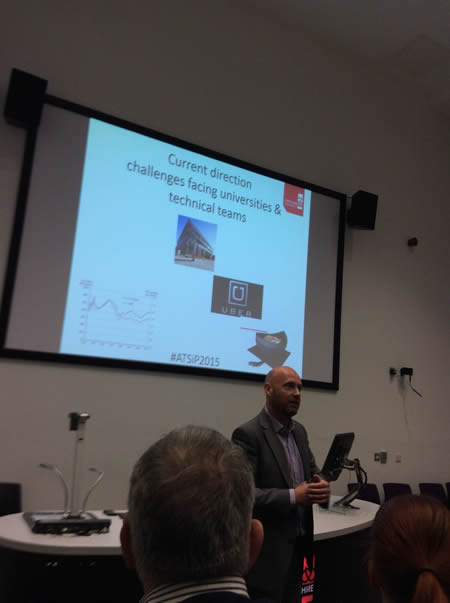 |
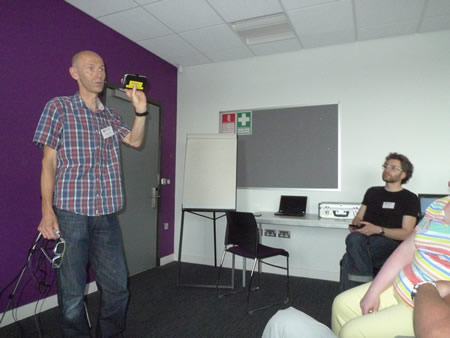
Richard Lilley |
Demo: Natural Gaze, RED-n & RED250 Mobile Eyetracking
Richard Lilley
Tracksys Ltd
SensoMotoric Instruments (SMI) are one of a small number of companies that produce high-end eyetrackers. One of their strengths is their R&D focus. In the last 3 months this had led to the development of two new systems—‘Natural Gaze’ and the ‘RED-n’. The former is the current state-of the art for mobile eyetracking, and the latter is the latest generation of flexible, highly portable screen-based systems. Richard from Tracksys (who distribute for SMI) will run a workshop, so attendees can try out the new kit for themselves.

|
Gesture Recognition and 3D Skeletal Analysis with Microsoft Kinect v2
Martyn AtkinsPlymouth University
I’ll talk about some recent experiments I’ve programmed to recognise participants’ full-body movements and gestures in real time using the new Microsoft Kinect v2 Sensor for windows and its associated software development kit (SDK). Hopefully I can rig up a live demo of gesture recognition by bringing a sensor and laptop with me. Should be of interest to folks as the sensor kit is very powerful indeed and only costs about £200 off-the-shelf. Additionally, the SDK provides some very powerful free software and a rich programming framework using Microsoft .NET (typically C# or VB).
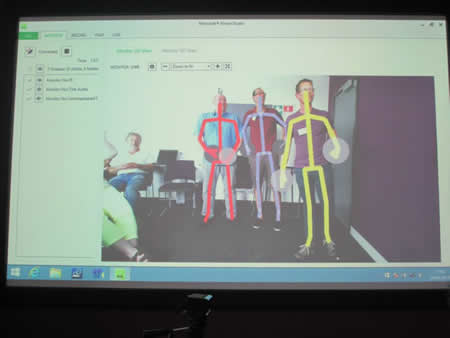
|
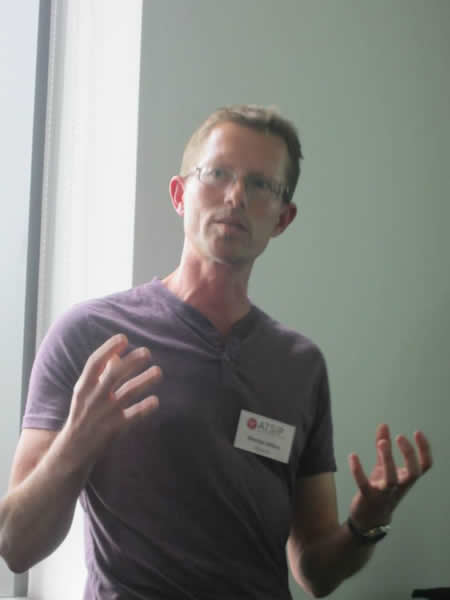
Martyn Atkins |
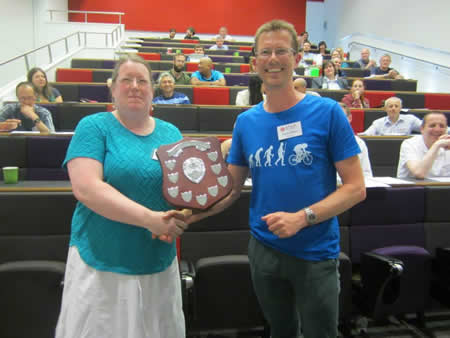
Martyn Atkins receiving Ken Nicholson Award for the best presentation
|
Discussion: Implications of Major Experiment Generator Vendors’ Suggestion that Accurate Timing Requires External Chronometry and Purchase of Their Devices
Dr Richard Plant, The Black Box Toolkit Ltd
Organiser’s note: Richard has suggested this as a topic for an informal discussion
There are developments afoot in the experiment generator world which may cause some raised eyebrows and which are likely to spark a lively debate amongst the ATSiP members and wider psychology community.
One example is the upcoming USB based Chronos hardware from PST the makers of E-Prime that promises to solve audio presentation timing issues by storing audio files in its own RAM and mixing them on the fly thus bypassing users’ soundcard altogether in experiments! To date Chronos has not been released and is still in beta (papers in press).
Does this matter and what are the implications for past publications and also for people who don’t use the device?
It is worth contrasting this with the shift to web-based experiment generators and what the trade-offs are. Does it matter, when does it matter and should you care? Do web-based experiment generators represent a new gold rush?
|
|
|
Departmental Tour |
Paul Gallimore and Sarah Higgins conducted 2 groups in a tour of the department. |
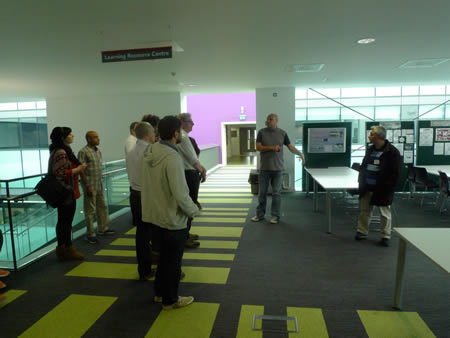 |
 |
|
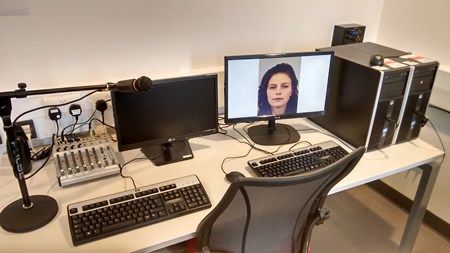 |
|
|
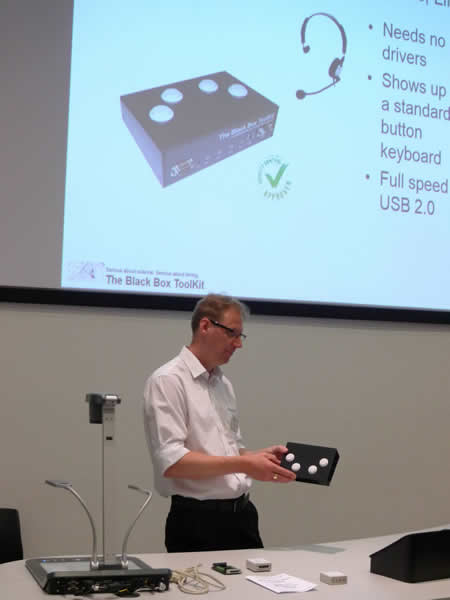
Dr Richard Plant, York University
|
Demo: Event Marking and Time Stamping with the new mBBTK, TTLviaUSB or BBTK Carbon Fibre Response Pad with Built-in Voice Key
Dr Richard Plant, The Black Box Toolkit Ltd
We’ve a major new product in development which we’d like some feedback on from people who might use it or have to support it in the field! We’d value your views on the mBBTK which is designed to take over timing duties in a range of experiments and also event mark in real-time in settings such as EEG, MRI, eye-tracking etc. etc. In short 40 channels, with TTL I/O, opto-detectors, mics, voice keys, a response pad, its own RAM and CPU, Bluetooth option for data transfer and control, etc., etc.. What do you think to it? Will it work for you? Now’s the chance to comment before it goes into production.
I will also demo our new TTLviaUSB module that has 16 TTL lines (8 in / 8 out) and is a drop in replacement for a parallel port for simple event marking. It has integrated timing checks and works with any experiment generator or experiment you have written yourself and runs on any platform.
The final demo will be of our upgraded 4-8 button carbon fibre response pad which now has a built-in voice key. The voice key works just like the standard buttons and produces a normal keystroke. It uses full-speed USB to achieve millisecond accuracy and appears as a standard keyboard and so works with any experiment generator on any platform.
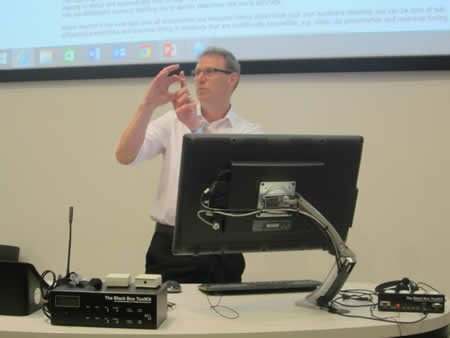
Dr Richard Plant, York University |
The Links Between Delivery of Essential Technical Skills and Core Teaching
Paul Gallimore and Sarah Higgins, Staffordshire University
This talk will provide an insight into how CPD and experience have enhanced and developed our teaching skills and knowledge base; this has enabled the integration of practical technical sessions within theory based modules. We will also provide an interactive element so that you can experience how this can be achieved!
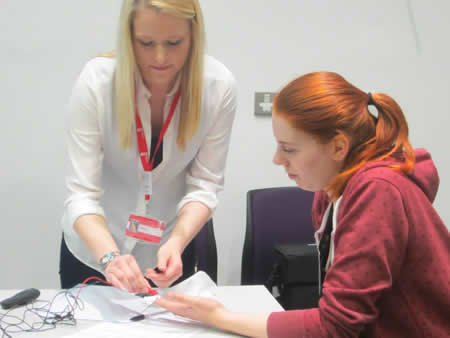
|
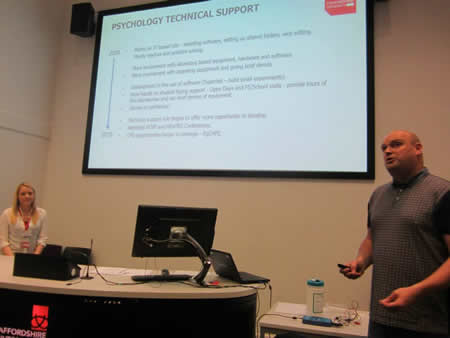
Paul Gallimore & Sarah Higgins
|
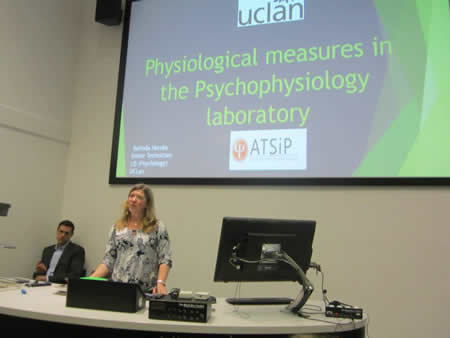
Belinda Fay Hornby |
Stress and Physiological Processes in the Psychology lab: Measuring Anxiety with Biopac
Belinda Fay Hornby, University of Central Lancashire
This talk will cover a range of paradigms and equipment, from basic blood pressure monitors, to Eduloggers through to the Biopac and beyond, to measure physiological responses in the psychophysiology laboratory. Finally, the talk will end with a brief talk about a study done to elicit and measure anxiety using psychological measures of state trait anxiety (Spielbergers state trait anxiety inventory) and positive and negative affect (PANAS) and the Biopac to measure the physiology.
Belinda wrote a personal account of her experiences at her first ATSiP Conference, which can be read here. |
New BIOPAC Products and Developments
Robert Jones and Steven Clifford, Linton Instrumentation
A number of new products and software features have recently been added to the BIOPAC range of data acquisition systems. The latest device is the BioNomadix Logger which allows the researcher to record data from up to three BioNomadix dual channel wearable transmitters, enabling laboratory quality recording outside of lab conditions. We will demonstrate the new Logger as well as discuss other new devices and features such as support for the Mobita 32 channel wireless biopotential recording system.
Time permitting we will also discuss integration with 3rd party systems using a simple demonstration of biofeedback with physiological parameters fed in real-time to a virtual reality system.
|
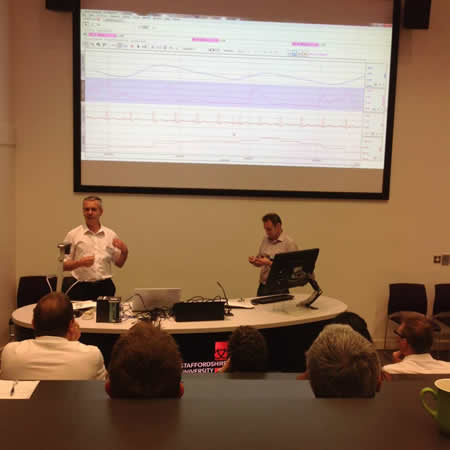
|
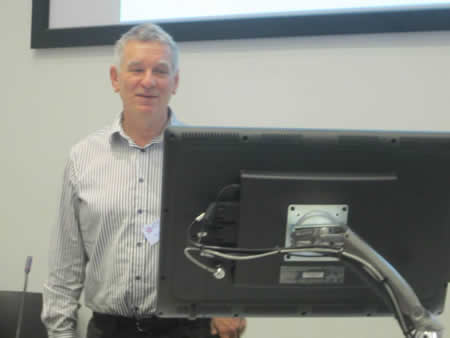
Noel Taylor |
Using the EyeTribe Eye Tracker
Noel Taylor, University of Hertfordshire
The ‘EyeTribe’ is technically similar to the Tobii X2, but at a fraction of the cost. It comes with an SDK that consists only of a very smooth calibration routine and a bunch of commands in Python, C#, C++ or Java. These commands can be used in scripts to start calibration, start recording, stop recording etc. There are, however, several ways in which it can be used without the need for programming skills and the talk will demonstrate three freeware solutions.

|
How the EyeLink 1000 and Associated Software Have Enhanced Research Relating to Consumer Choice
Jenny Parfitt-Bowman and Sarah Higgins, Staffordshire University
This talk will outline how the EyeLink 1000 has been used within research projects undertaken at Staffordshire University. The two projects focus on consumer behaviour in relation to brand recognition and nutritional importance.
|
 |

Andrew Barnes
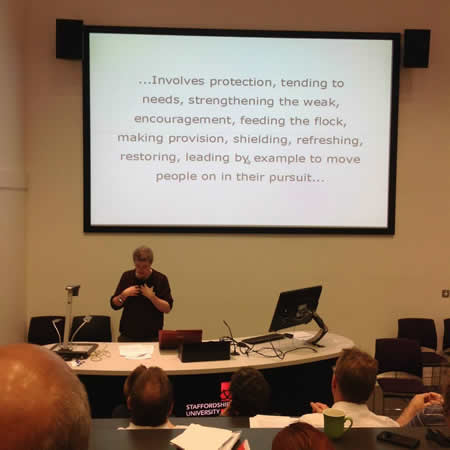
|
The Unseen Technician
Andrew Barnes, University of Surrey
“The History of Technicians”
We go back a lot further than I thought and our role is only recently beginning to be recognised and appreciated.
“What a Technician is” - that isn’t technical
We are [frequently] the institutional glue/memory. We are [often] parallel to but not part of the academic structure and that can give us a different viewpoint and that can be useful to us and to others.
We may be the only people that interact will all the levels of our schools/departments on a daily basis, from first year undergrads to Doctoral candidates, newbie lecturers to senior professors, and expert users to nervous first timers.
“How do we do that?”
Our work and how we work affects people every day as well “important” things like the NSS and PTES [and even the REF].
Is there “Best Practice” to be learnt/shared? How do we help everyone to their best outcomes? Be that Teaching, Learning or Research.
[With apologies in advance to Terry Pratchett]
|
| Friday 26th June 2015 |
|
Developing a Preschool Diagnostic Methodology for Dyslexia
Maria Shaw, Edinburgh Napier University
Napier Psychology Department in conjunction with the Computing Science Department is currently running a research project looking at “visuo-motor integration” in dyslexia. The theory behind the study is that some parts of the brain might work differently in dyslexics compared with people who do not have dyslexia.
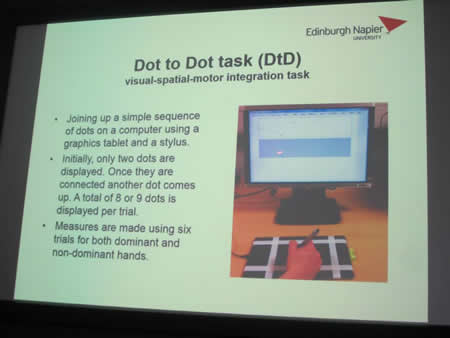
|
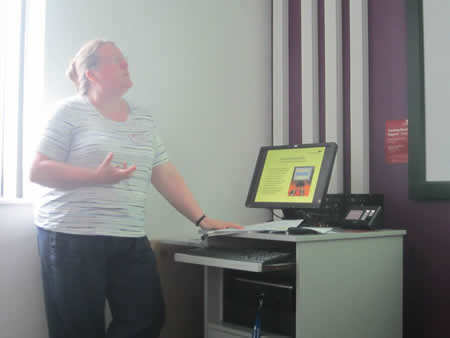
Maria Shaw
These parts of the brain are involved in aspects of vision and visual attention, and also in co-ordinating movements. This theory is being tested by exploring how well people use visual information to guide their hand movements, using a PC based “dot-to-dot” task with a graphics pad and stylus developed by the Computing Science department and measuring eye movements using SMIs eyetracking glasses. |
Vertical Enhancement of Statistics and Psychology Research
Wakefield Carter, Oxford Brookes University
The psychology demonstrators at Oxford Brookes University are currently working on a project (VESPR) to enhance the quality of students research and statistical knowledge. via increased integration of methods modules, increased interaction between cohorts and engagement with alumni. A key feature of the project is an open Moodle resource with sections supporting each stage of the research process: literature review, ethics, research, analysis, writing and dissemination. It also includes and additional careers section as a focus for voluntary work, internships and links with alumni. So far VESPR has supported two alumni networking events, two student submissions to Psych-Talk magazine based on second year experiments and seven student posters for the 2015 BPS conference based on third year dissertations. It is funded by a Brookes Team Teaching Fellowship Award (2014-2016) but will be sustainable beyond this period.
|
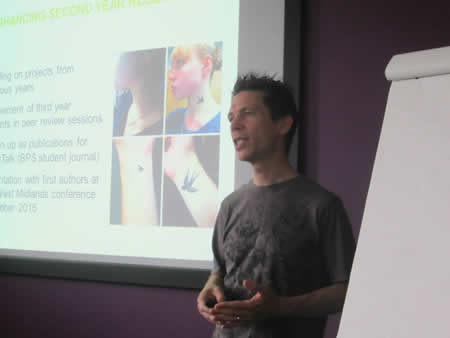
Wakefield Carter |
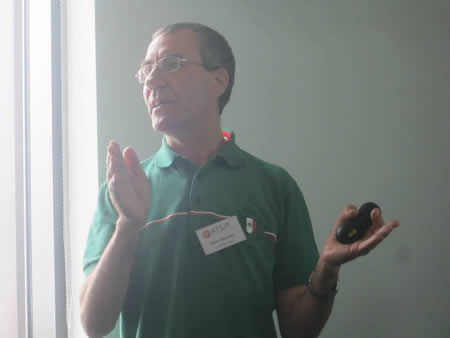
Pete Beaman |
Do They Know Us? Do They Like Us?
Peter Beaman, Loughborough University
- Feedback from Social Psychology Undergraduate Students at Loughborough University in respect of BPS guidelines/accreditation.
- Knowing their specialised technician; including Perceived Skill Set and Personal Attributes plus their own experiences/comments.
- Some complimentary data from another dept is also examined for differences and similarities.
- Discussion of how this impinges on the Student Experience/wider context.
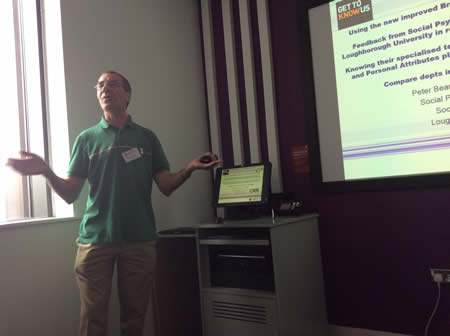
|
Curry 7, the new Software Platform for EEG/ERP Acquisition, Signal Processing, Source Localisation and NeuroImaging from Compumedics Neuroscan
Miguel Angel Rodriguez
Advanced Medical Equipment Ltd.
CURRYSCAN 7 Neuroimaging Suite
For more than 25 years Neuroscan has developed and provided world class tools for EEG data processing and signal analysis. The SCAN software has served as the primary tool for EEG applications in more than 3000 labs around the world. While SCAN has seen many updates throughout the years and still maintains a leading position in data acquisition and processing software, the time has come for a significant change in the way we think about data processing and analysis.
This change is the new CURRY®; 7 Neuroimaging Suite. The CURRY®; 7 Neuroimaging Suite is replacing the SCAN software as our acquisition and data processing software. The history of the CURRY software is well known. Throughout the world, CURRY has the well-deserved reputation as the most advanced and comprehensive tool for Multimodal Neuroimaging. CURRYs strength has always been centered on combining functional data such as EEG and MEG with imaging data from MRI and CT to optimize source reconstruction. Now we are combining CURRYs strength with the acquisition and signal processing features of the SCAN software for a comprehensive EEG acquisition, data analysis, source localization and source imaging package.
In this presentation we will introduce the new Curry 7 modules for: Data Acquisition (X), Signal Processing (S), Basic Source Localisation (B) and Advanced Source Localisation (A). We will discuss licensing structure, explore the features of each module and discuss their strengths and advantages. We will also introduce 2 new amplifiers from Neuroscan, The Grael and the Synamps Wireless amplifiers that together with the well-known Nuamps and Synamps RT conform the new product ranges in amplifiers from Neuroscan for your EEG/ERP/EP Research |
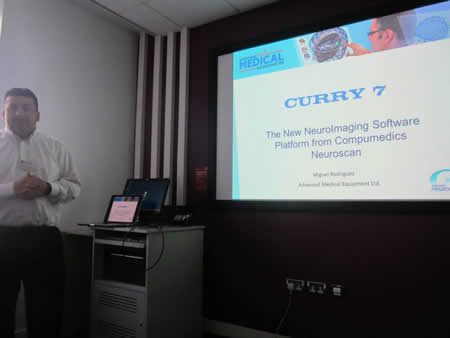 |
|
 |
Keeping it real: the disconnect between academic and everyday statistics
Wakefield L. Carter, Aspasia E. Paltoglou and Emma L. Davies
Oxford Brookes University
Research methods and statistics comprise a large proportion of a psychology degree; however evidence suggests that some students face difficulties, and sometimes even anxiety about this aspect of their studies (Onwuegbuzie, 2004).
As part of our Brookes Team Teaching Fellowship project, 159 psychology students completed an online questionnaire assessing statistics anxiety and related GCSE mathematics knowledge. Principle components analysis suggested that anxiety could be split into four components: academic interpretation, exams, asking for help, and real world interpretation. Joint honours students were found to be significantly more confident with real-world applications of statistics and also performed better on the mathematics questions.
In conclusion, we propose that psychology students need more support with the simplest foundations of statistics, such as decimals and percentages, and that these should be related to real world applications.
|
Discomfort, Distraction and Virtual Reality: Can the use of Active Distraction Techniques over Passive Distraction reduce the experience of an experimentally induced physical discomfort within a healthy adult population?
Patrick Boylan
Dublin City University
Objective: The research aimed to discover through the use of active and passive distraction techniques including Virtual Reality (VR) whether active distraction greater reduces physical discomfort in a healthy adult population.
Method: Participants were 27 students aged 18 and above, 14 females and 13- males, recruited from the authors institution. The study was a mixed method within subject design consisting of 3 groups in which participants took part in 4 tasks, a baseline, watched a video clip, played a Lego computer game and explored a VR world using an Oculus Rift Head Mounted Display (HMD). In all four test conditions participants were asked to hold their non-dominant leg at a height of approximately 30cm from the floor, up to a maximum of 5 minutes while sitting on a chair.
Results: The discomfort tolerance scores demonstrated positive results in tasks requiring greater activity and involvement (presence), with the VR task having the greater effect.
Conclusion: The evidence suggested that active distraction combined with higher levels of a sense of presence had the ability to greater reduce discomfort experienced by healthy adults undergoing a laboratory induced discomforting condition.
|
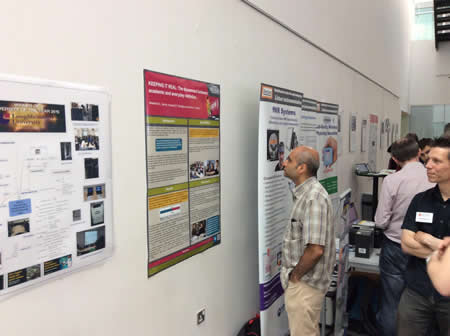 |
 |
Use of CANTAB Cognitive Assessment for Research, Learning and Teaching
R. Law, H. Zacharia, & L. Mandzukic-Kanlic
University of Westminster
Use of Cantab touch-screen computers offers portable, culturally neutral and language independent tests of cognitive function that can be easily compared between studies. The presented studies involved exploration of cognitive performance and the association with morning levels of the hormone cortisol. This association was initially explored in a 50-day case study of a healthy young adult male (age 24), and recently followed-up in a between-subjects study of 55 healthy young adults (82regression modelling of variation in cortisol concentrations indicated that within the single case study, the greater the increase in cortisol concentrations from 0-30 min post-awakening (CAR) the better was subsequent EF performance at 45 minutes post-awakening (t = 2.29, p = .024), with early analysis of the second study suggesting a similar effect between participants. These findings have implications for the understanding of the relationship between morning cortisol secretion and cognitive function. The studies highlight the advantages of CANTAB testing for reliable, valid test results, and convenience for comparison of results between studies.
|
Beyond Surveys: The PsyTech Qualtrics Bots
Karolyn Webb
Anglia Ruskin University
Qualtrics is a popular insight platform that is widely used across various settings, in both business and academia, to collect data, opinions and surveys. Qualtrics offers developers various methods to modify the standard operating platform, allowing it to be used for innovative functionality beyond simple surveys. The Department of Psychology at Anglia Ruskin University have been creating bespoke Robots (Bots) to handle and administer various aspects of complex, multi-user processes that are not fully automated
The current poster considers the application of some of these advanced techniques and modifications to maximise the efficiency and automation of a number of complex administrative process within the University. We consider these within the context of functional and useful Bots, designed to automate administrative processes, improve accessibility and usability for students subsequently improving the student experience whilst reducing administrative workload on staff.
We will consider the use of Survey Flow to create responsive and interactive feedback systems, passing information through query strings to integrate external systems (such as SONA), REST API data automation, E-Mail and Panel triggers; quotas and display logic to produce a priority/preference supervisor allocation system.
Applications of these techniques can be seen across the Bots used in the department such as the EthicsBot which I used to handle applications for Ethical Approval, the Personal Development Plan Bot, the Supervisor Allocation Bot and the Assessment Offences Bot. In addition to this, we discuss the use of Query Strings to automatically allocate credits in SONA whilst still using anonymous survey links. Whilst currently still in review, these systems have simplified communication across the department, standardised data collection and recording; and feedback suggests that staff and students feel they are an improvement over the previous paper based systems.
|
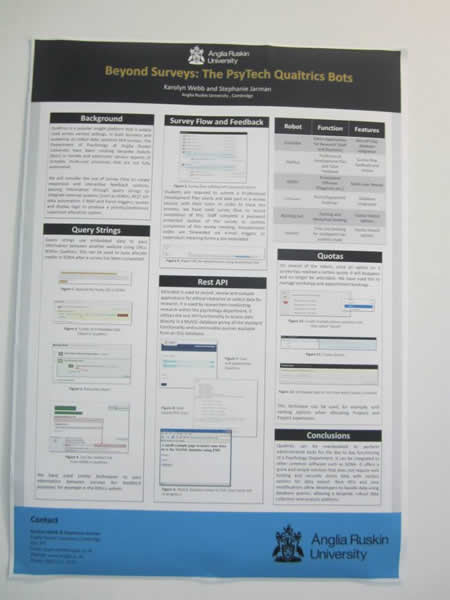
|
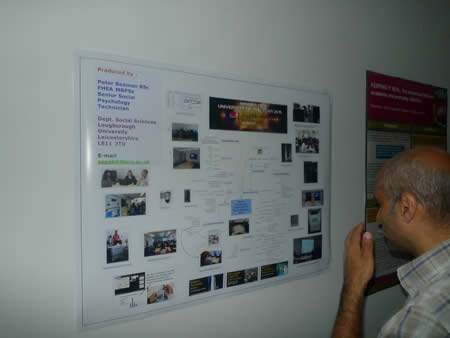 |
Redesigning Social Psychology Laboratories
Peter Beaman
Loughborough University
This poster shows the recent infrastructural changes to the Social Psychology Laboratories in the department of Social Sciences at Loughborough University.
This mind-map array shows the developmental stages of creating a new fit for purpose laptop based and supported Lab, and the associated ancillary resources like Digital CCTV Lab/Observation rooms and other Research areas within the dept. The various uses for the labs is noted as are the suppliers used the time scale involved in the project. Note that the SP laptop Lab now has served as pivotal and leading example of efficient and flexible learning space and has given to several new areas of IT development both within and outside the University
|
 |
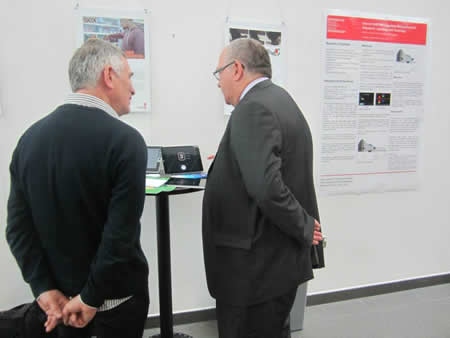 |
| |
|
|
|



